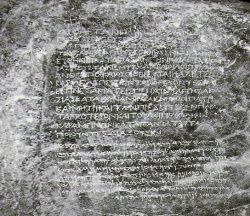Humane King Sutra
The Humane King Sutra (Chinese: 仁王經; Renwang jing Japanese: Ninnō-kyō) is one of the more influential of the East Asian Buddhist apocryphal scriptures texts that although purported by their unknown authors to be translations of Indian works, were actually composed in China and Korea. Although its full title indicates that it is a prajñāpāramitā (transcendent wisdom) text, it is better characterized as a blend of transcendent prajñā, yogācāra, and tathāgatagarbha teachings. The full name is the Prajnaparamita Sutra for Humane Kings Who Protect their Country.
This sutra is unusual in the fact that its target audience, rather than being either lay practitioners or the community of monks and nuns, is the rulership (i.e. monarchs, presidents, prime ministers, etc.). Thus, for example, where the interlocutors in most scriptures are arhats or bodhisattvas, the discussants in this text are the kings of the sixteen ancient regions of India. The foregrounded teachings, rather than being meditation and wisdom, are "humaneness" and "forbearance", these being the most applicable religious values for the governance of a Buddhist state. Hence today in some Chinese temples, the sutra is used during prayers on behalf of the government and the country.
Another distinctive characteristic of this scripture is that a second "translation" was carried out a few centuries after the appearance of the original version, by the monk Amoghavajra (Pukong 不空), one of the most important figures in the Chinese Esoteric tradition, as well as a patriarch in the Shingon sect of Japan. But this new version was actually just a rewrite, since there was no original Sanskrit version.[citation needed] This second version of the text (仁王護國般若波羅蜜經, T 246.8.834-845) while based mostly on the original version (仁王般若波羅蜜經, T 245.8.825-834), the translation of which was attributed to Kumārajīva, contains new sections that include teachings on mandala, mantra, and dhāraṇī.
In the same way that such other apocryphal works, such as the Brahma's Net Sutra, came to hold a special authoritative position in the subsequent development of Buddhism in Korea and Japan, as well as China, the Humane King Sutra became the standard model text in these East Asian countries for Buddhist-based state protection and statecraft, along with the Golden Light Sutra.
Translations
There are two classical Chinese translations extant:
- the 仁王護國般若波羅蜜經 Renwang Huguo Bore Boluomi Jing (trans. by Kumārajīva).
- the 仁王護國般若波羅蜜多經 Renwang Huguo Bore Boluomiduo Jing (trans. by Amoghavajra). Amogavajra translated the mantras.
The discovery of the Old Translated Inwanggyeong (구역인왕경;舊譯仁王經) in Gugyeol in the mid-70s contributed to Middle Korean studies.
